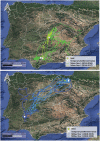The variability of juvenile dispersal in an opportunistic raptor
- PMID: 37351299
- PMCID: PMC10284106
- DOI: 10.1093/cz/zoac039
The variability of juvenile dispersal in an opportunistic raptor
Abstract
The juvenile dispersal of raptors is a crucial stage that stretches from parental independence to the establishment of the first breeding area. Between 2012 and 2020, 44 juvenile red kites Milvus milvus from the Spanish breeding population were tagged using GPS telemetry to study their dispersal. Juveniles left the parental breeding area at the end of their first summer and performed wandering movements throughout the Iberian Peninsula, returning to the parental breeding area the following year, repeating the same pattern until they settled in their first breeding area. We analyzed the mean distance from the nest, the maximum reached distances, and the traveled distances (daily and hourly) during the first 2 years of dispersal and compared them. Despite the high individual variability, variables describing the dispersal movements of juveniles showed a decreasing trend during the second dispersal year: 80% of individuals reached a shorter maximum distance in the second year, 70% decreased their mean distance to the nest, 65% decreased their hourly traveled distances, and 50% decreased their daily traveled distances. On the other hand, the red kites usually combined wandering movements with the establishment of temporary settlement areas (TSA). The average duration of settlement in the TSAs was 75 ± 40 days (up to 182 days) and was located at 182 ± 168 km from the nest. In those areas, juveniles used 781.0 ± 1895.0 km2 (KDE 95%). Some of the TSAs were used by several individuals, which suggests that these areas might be good targets for conservation in future management plans.
Keywords: GPS telemetry; landfills; movement ecology; natal dispersal; red kite; spatial ecology.
© The Author(s) 2022. Published by Oxford University Press on behalf of Editorial Office, Current Zoology.
Figures






References
-
- Aebischer A, Scherler P, 2021. Der Rotmilan: Ein Greifvogel im Aufwind. Germany: Haupt Verlag
-
- Balbontín J, Ferrer M, 2009. Movements of juvenile Bonelli’s eagles Aquila fasciata during dispersal. Bird Study 56(1): 86–95.
-
- Bird Life International. 2021. Red Kite (Milvus milvus)—BirdLife species factsheet. BirdLife International. Available at: http://datazone.birdlife.org/species/factsheet/red-kite-milvus-milvus/refs
-
- Bustamante J, 1993. Post-fledging dependence period and development of flight and hunting behaviour in the red kite Milvus milvus. Bird Study 40(3): 181–188.
-
- Cadahía L, López-López P, Urios V, Negro JJ, 2010. Satellite telemetry reveals individual variation in juvenile Bonelli’s eagle dispersal areas. Eur J Wildl Res 56(6): 923–930.
LinkOut - more resources
Full Text Sources
Research Materials
